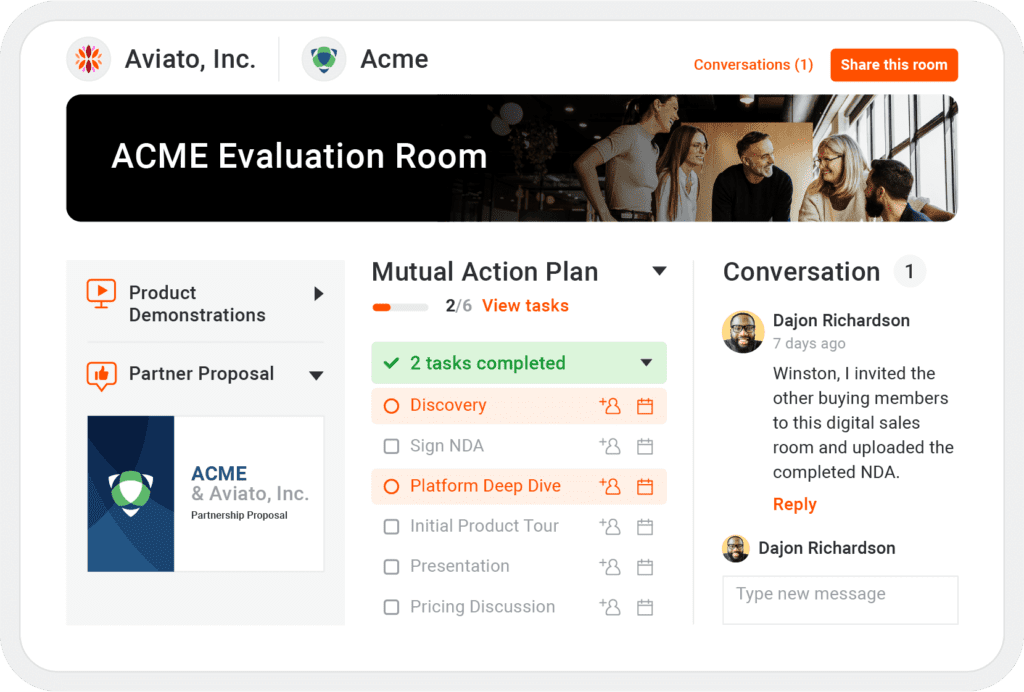Revenue leaders are always looking for strategies to boost the bottom line. Two practices they often turn to are revenue enablement and revenue operations.
Perhaps you’re unsure what the difference is between revenue enablement and revenue operations. Or maybe you’re weighing revenue enablement vs revenue operations to determine which practice will help you grow revenue.
Spoiler alert: you need both.
Combining revenue enablement and revenue operations is the most effective way to boost business results.
In this post, we’ll explore how revenue enablement and revenue operations differ, how they’re similar, and why you need both practices to drive revenue growth.
Revenue operations vs revenue enablement: How are they different?
Let’s start at the beginning, by defining both revenue enablement and revenue operations.
You’re likely familiar with sales enablement and sales operations. You can think of revenue enablement and revenue operations as the next iteration of these two practices.
What is revenue enablement?
Revenue enablement is the next generation of sales enablement. It is a practice focused on equipping all customer-facing roles—including sales, marketing, customer success, and customer service—with the tools, training, information, and resources they need to deliver outstanding, connected experiences throughout the customer lifecycle.
When revenue teams are equipped to deliver great experiences, the business is better positioned to win new customers and retain existing ones.
What is revenue operations?
Revenue operations (also known as revenue ops or RevOps) is focused on empowering revenue organizations to be as productive as possible. Revenue operations teams achieve this goal by streamlining processes, improving data visibility, and aligning go-to-market teams. They work behind the scenes to ensure an organization’s revenue generation machine runs on all cylinders.
What’s the difference between revenue operations and enablement?
There are many similarities between revenue operations and revenue enablement. For starters, both teams aim to increase revenue teams’ effectiveness and efficiency.
But the ways revenue enablement and revenue ops teams achieve their goals is different.
Revenue enablement vs revenue operations: How they achieve their goals
Revenue enablement teams develop tools and resources to ensure customer-facing teams have what they need to engage with customers across the lifecycle. Some examples of revenue enablement tools and resources include:
Revenue enablement aligns all customer-facing teams. That way, customers have seamless experiences across their entire relationship with an organization. Great experiences increase sales, customer satisfaction, and customer retention.
Revenue operations teams work to optimize the revenue generation process. Successfully generating revenue involves dozens of moving pieces, and revenue ops teams work to ensure the process is as efficient as possible.
Revenue operations teams achieve their goals in several ways, including:
- Optimizing the sales process
- Ensuring sales data is accurate and that the right people have access to the right data and analytics
- Implementing and managing new sales tools
- Analyzing revenue metrics
Revenue enablement vs revenue operations: Who is responsible?
Another key difference between revenue enablement vs revenue operations is who is responsible. Revenue enablement is typically owned by a revenue enablement team. Revenue operations, on the other hand, is owned by a revenue operations team. Typically, each of these teams reports up to the chief revenue officer (CRO) or other revenue leader.
Both revenue enablement and revenue ops teams must collaborate with key teams throughout the organization, including sales and marketing.
Revenue enablement vs revenue operations: How do they measure success?
Revenue enablement and revenue operations both aim to increase productivity. As such, both practices measure success with many of the same KPIs, including
- Win rates
- Customer acquisition cost
- Customer lifetime value
Revenue enablement teams track certain additional KPIs. For example, they track KPIs related to how customers and sales reps engage with sales content and how that content impacts sales outcomes. Revenue enablement teams also track adoption and consumption metrics, such as what portion of the sales team completes an assigned training.
What tools do they use?
Revenue enablement and revenue operations teams require the right tools for success. One key tool used by both is a revenue enablement platform.

Revenue enablement teams use revenue enablement software to create and deliver personalized enablement to help each member of the revenue team build the skills necessary for success. They can also use a revenue enablement platform to measure the impact of their programs so they can optimize them properly.
Revenue operations teams use an integrated revenue enablement platform to consolidate the tech stack and drive sales productivity.
| Revenue enablement | Revenue operations | |
|---|---|---|
| Goal | Increase the effectiveness and efficiency of customer-facing teams | Increase the productivity of revenue organizations |
| How they achieve their goal | Equip customer-facing roles with the tools, resources, training, and data they need to engage customers throughout the customer lifecycle | Streamline processes, improve data visibility, and align go-to-market teams |
| Audience |
All customer-facing teams, including
|
All customer-facing teams, including
|
| Responsible party | Typically, a revenue enablement team | Typically, a revenue operations team |
| Who they report to | Chief revenue officer or other revenue leader | Chief revenue officer or other revenue leader |
| Examples of tools | Point revenue enablement tools or an integrated revenue enablement platform | Revenue enablement platform |
| How the team uses a revenue enablement platform | Build, deliver, and measure enablement programs and initiatives that empower customer-facing teams to master the skills necessary for success | Streamline the tech stack and boost sales productivity |
| Examples of KPIs |
|
|
What are the roles and responsibilities of revenue operations and enablement?
Now that we’re aligned on the key differences between revenue enablement and revenue operations let’s examine the roles and responsibilities of each team more closely.
Revenue operations roles and responsibilities
Who owns revenue operations?
As we mentioned earlier, revenue operations are typically the responsibility of a dedicated revenue operations team. The team most often reports to the chief revenue officer (CRO) or another revenue leader.
The makeup of a revenue operations team varies from company to company. However, some examples of RevOps roles include:
- RevOps manager
- VP of RevOps
- RevOps specialist
While the RevOps team leads the revenue operations charge, they must collaborate closely with other key teams including sales and marketing. This helps ensure alignment and that RevOps initiatives align with the overall revenue strategy.
The roles and responsibilities of the revenue operations team vary. However, some examples of revenue operations responsibilities include:
- Collaborating on sales forecasts
- Optimizing the sales process
- Ensuring sales data is complete and accurate and that all members of the revenue team have access to the right data
- Contributing to revenue strategies
- Collaborating with other teams to ensure initiatives are aligned with business goals
- Implementing and administering technology for use by the revenue team, such as a revenue enablement platform
- Regularly analyzing revenue metrics to identify opportunities for optimizations
Revenue enablement roles and responsibilities
Who owns revenue enablement?
Increasingly, revenue enablement is owned by a dedicated revenue enablement team. Mindtickle research found that 84% of organizations invest in a dedicated enablement team. The revenue enablement team typically falls under the purview of a CRO or another revenue leader.
Some examples of revenue enablement roles include:
- Revenue enablement manager
- VP of revenue enablement
- Revenue enablement specialist
Effective revenue enablement is a team sport. Revenue enablement teams must regularly collaborate with teams including sales, marketing, and customer success to ensure everyone is aligned and working toward the same goals.
The responsibilities of the revenue enablement team vary. However, some examples of revenue enablement responsibilities include:
- In collaboration with other teams, defining the necessary skills and behaviors for each customer-facing role
- Developing onboarding and ongoing learning programs to ensure each revenue team member can build the skills necessary for success
- Collaborating with marketing and sales to develop sales content for team members to use throughout the sales cycle – as well as training and enablement on how to best use content
- Developing a coaching strategy to ensure managers have the tools, data, and resources to deliver coaching that improves business results
- Regularly measuring the impact of revenue enablement initiatives to make data-based optimizations
Combining the power of revenue operations and revenue enablement to grow revenue
Revenue enablement and revenue operations are both impactful practices. But when considering revenue enablement vs revenue operations, which is the better option for your business?
The truth is, you need both. Revenue operations and revenue enablement are both critical to revenue growth. While revenue enablement ensures teams have the right tools and resources to engage customers, revenue operations work to optimize the process of generating revenue.
When you combine revenue operations with revenue enablement, you’ll experience a whole host of benefits, including:
Many teams play a role in revenue generation. Yet often, these teams work in silos. Revenue enablement and revenue operations help align key teams, including sales, marketing, and custo
Revenue enablement ensures sellers master the skills and behaviors needed to close more deals. Revenue operations ensure processes are streamlined so sellers encounter less friction in the sales cycle and can move more deals to the finish line.
Research from Salesforce found that sales reps spend less than 30% of their time selling. Most of the time is spent on laborious tasks like searching for content or logging activities. Revenue enablement makes it easier for sales reps to find everything they need quickly. Revenue operations, on the other hand, ensure processes are as efficient as possible. Both revenue operations and revenue enablement ensure sales reps can spend less time on administrative work and more time actually selling. That means sales reps can shorten the sales cycle and close more deals faster.
B2B customers have high expectations – no matter where they are in the customer lifecycle. Revenue enablement and operations equip revenue teams with the right tools, technology, processes, and information to meet customers’ expectations. When customers’ expectations are met consistently, their satisfaction grows.
When B2B customers are satisfied, they’re more likely to stick around long-term. In addition, satisfied customers are more likely to be open to future cross-sales and up-sells. This increases their lifetime value.
Revenue operations and enablement are critical to revenue growth. When customer-facing teams have the right tools, resources, data, and processes in place, they’re better equipped to close new business and retain existing customers, leading to revenue growth.
The winning combination for driving revenue growth
It’s not a matter of revenue enablement vs revenue operations. Instead, revenue enablement and operations are necessary for a winning revenue strategy.
While revenue enablement ensures customer-facing teams have the right tools, information, and resources, revenue operations ensure that growing revenue is as seamless as possible.
Both revenue enablement and operations teams depend on the right tools to power their strategies and programs. An integrated revenue enablement platform is one essential tool.
Revenue Enablement in Mindtickle
Ready to see why winning revenue operations and revenue enablement teams are choosing Mindtickle to increase the impact of their initiatives?
Request Your Demo


 By Rahul Mathew
By Rahul Mathew

